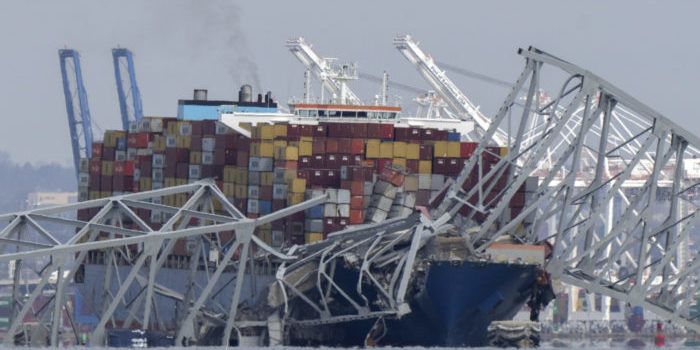(Headline USA) The horrifying collapse of a bridge on a major interstate artery in Baltimore, which sent at least 10 cars plunging into the frigid water in the wee morning hours, will have serious ripple effects on both travel and supply chains, even as a busy travel weekend approaches for returning spring-breakers and those visiting family over Easter and Passover.
“Losing this bridge will devastate the entire area, as well as the entire East Coast,” state Sen. Johnny Ray Salling said.
A container ship lost power and rammed the Francis Scott Key Bridge early Tuesday, causing the span to buckle into the Patapsco River below, and plunging a construction crew and several vehicles into the dangerously cold waters. Rescuers pulled out two people, but six others were missing.
The ship’s crew issued a mayday call moments before the crash took down the bridge, enabling authorities to limit vehicle traffic on the span, Maryland’s governor said.
The ship struck one of the bridge’s supports, causing the structure to collapse like a toy. It tumbled into the water in a matter of seconds—a shocking spectacle that was captured on video and posted on social media.
The vessel caught fire, and thick, black smoke billowed out of it.
With the ship barreling toward the bridge at “a very, very rapid speed,” authorities had just enough time to stop cars from coming over the bridge, Maryland Gov. Wes Moore said.
“These people are heroes,” Moore said. “They saved lives last night.”
The crash happened long before the busy morning commute on the bridge that stretches 1.6 miles.
The six people still unaccounted for were part of a construction crew filling potholes on the bridge, said Paul Wiedefeld, the state’s transportation secretary said. One of those rescued was taken to a hospital, he said.
“Never would you think that you would see, physically see, the Key Bridge tumble down like that. It looked like something out of an action movie,” said Baltimore Mayor Brandon Scott, calling it “an unthinkable tragedy.”
The collapse is almost sure to create a logistical nightmare for months, if not years, along the East Coast, shutting down ship traffic at the Port of Baltimore and snarling cargo and commuter traffic.
Highway signs as far south as Virginia warned drivers of delays associated with the closure of the bridge.
Authorities said sonar had detected vehicles in the water, which is about 50 feet deep. The water temperature was about 47 degrees Fahrenheit before dawn Tuesday, according to a buoy that collects data for the National Oceanic and Atmospheric Administration.
Earlier, Kevin Cartwright, director of communications for the Baltimore Fire Department, told the Associated Press that several vehicles were on the bridge at the time of the collapse, including one the size of a tractor-trailer truck.
The bridge came down in the middle of night when traffic would be lighter than during the day when thousands of cars traverse the span.
As the sun rose Tuesday, jagged remnants of the bridge could be seen jutting up from the water’s surface. The on-ramp ended abruptly where the span once began.
Cartwright said that some cargo appeared to be dangling from the bridge, which spans the Patapsco River at the entrance to a busy harbor. The river leads to the Port of Baltimore, a major hub for shipping on the East Coast.
Maryland Transportation Secretary Paul Wiedefeld said all vessel traffic into and out of the port would be suspended until further notice, though the facility was still open to trucks.
The governor declared a state of emergency and said he was working to get federal resources deployed. The FBI was on the scene, but said there was no credible information to suggest terrorism.
It was unclear whether Transportation Secretary Pete Buttigieg, who has become notorious for his perennial absenteeism in time of crisis, had any plans to visit
Last year, the Port of Baltimore handled a record 52.3 million tons of foreign cargo worth $80 billion, according to the state. In addition to cargo, more than than 444,000 passengers cruised out of the port in 2023.
Adapted from reporting by the Associated Press

